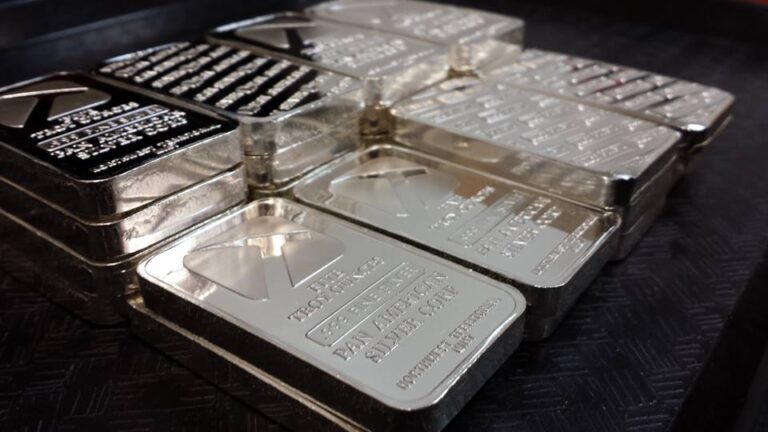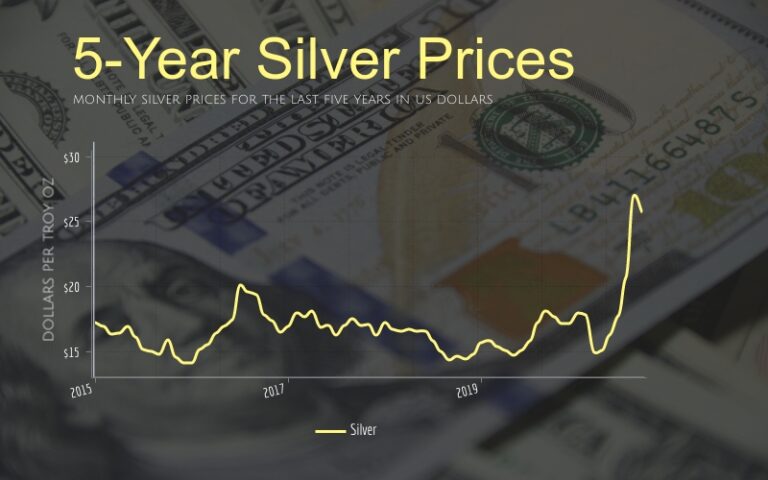Silver Price Per Ounce Last Year

Silver, the precious metal that’s been prized for centuries, saw a remarkable level of fluctuation in its price per ounce last year. From record highs to devastating lows, silver saw it all in 2020 – and investors everywhere were watching with bated breath as they waited to see what would come next.
The dramatic shifts in the market have left many questioning where silver prices will go in 2021 – and whether or not now is the time to invest. In this article, we’ll explore the factors affecting silver’s price per ounce last year, analyze trends from 2020, discuss forecasts for 2021, and offer tips on investing in silver.
Overview of Silver’s Price Per Ounce
This report provides an overview of the fluctuations in precious metal values over the past twelve months. Silver is a widely traded commodity and its price per ounce has been relatively volatile during this period, ranging from a high of $19.621 to a low of $14.239 throughout the year. This represents an approximate 30% fluctuation in value over that time, which is significant when compared to other precious metals such as gold or platinum which experienced volatility in the single digits.
The quarterly average for silver was $15.941 in Q1, $16.812 in Q2, $17.876 in Q3 and finally $17.717 in Q4 with most of the variance occurring within the first two quarters of 2020 before settling down towards the end of year as markets stabilized somewhat after some of their initial shocks due to COVID-19 related uncertainty subsided.
Overall it looks like silver prices have remained fairly stable on average throughout last year despite brief periods where they could have spiked or dropped significantly depending on market conditions at any given time – suggesting that long term investment strategies may still be viable for those looking to trade this asset class going forward into 2021 and beyond.
Factors Affecting Silver’s Price
Factors influencing the value of precious metals have a large impact on their market prices. The price of silver per ounce is no exception and is greatly affected by global forces, such as:
- Political unrest or economic uncertainty within countries that are major producers of silver
- Changes in market sentiment towards silver investment
- Interest rates set by central banks
- Broad movements in other commodities like gold, copper, or zinc
- Economic performance and industrial demand for silver-based products.
In particular, political instability within major producing countries can lead to sharp swings in the prices of silver per ounce. This is because disruptions to production could create shortages which then push up the price of this metal.
Similarly, changes in interest rates tend to affect investments across all asset classes including precious metals. A rise in interest rate often leads investors away from investing in silver, thus pushing down its price per ounce.
Furthermore, when there is an increase in economic activity around the world then the demand for industrial products made with silver increases leading to higher prices for this metal.
Silver Price Trends in 2020
The value of silver has been subject to fluctuations in 2020, with a number of factors contributing to its volatility.
Silver prices began the year around $17 per ounce and steadily increased until mid-March when prices hit a high of $18.75 per ounce. This was due largely to the coronavirus pandemic, which caused significant market uncertainty and increased investor interest in precious metals as safe havens during times of crisis.
From March until late July, silver prices declined slightly before increasing again towards the end of August as investors sought out commodities for their potential growth opportunities.
By October, silver had peaked at nearly $25 per ounce and then again dropped off in November before rebounding back up near its October highs by December.
The volatility in the price can be attributed to both economic conditions and geopolitical events throughout 2020 that created an environment where investors were constantly assessing risk versus reward opportunities within different asset classes.
While the overall trend for silver was upward, there are still many uncertainties ahead as we enter 2021 that will likely lead to continued fluctuation in precious metal prices over time.
Silver Price Forecast for 2021
As 2021 begins, investors are closely watching the silver market for potential growth opportunities or risks that may arise in the coming year. Due to the unpredictability of the current global economy and markets, many investors are uncertain as to what direction silver prices will take this year.
Silver prices have been relatively volatile over the past few years, with some analysts pointing to a possible trend of increasing prices due to economic conditions. Nevertheless, there is still no clear consensus on whether these predictions will come true or not.
Investors can look at recent trends in order to make an educated guess about where silver prices may be headed this year. Analysts agree that factors such as inflation and currency devaluations could lead to higher gold and silver prices throughout 2021.
Additionally, geopolitical tensions and increased demand from industrial applications could also factor into how much silver is worth by the end of 2021. As such, it’s important for investors to stay informed about current events in order to accurately predict possible future movements in silver price per ounce this year.
Tips for Investing in Silver
Investors looking to add exposure to silver in their portfolios should consider a few key components when making an investment decision. Firstly, they should weigh the potential risks and rewards of investing in silver compared to other asset classes.
Silver prices can be volatile, but they may offer a hedge against inflation and currency devaluation over the longer term. It is also important for investors to understand the fundamentals of silver, including supply and demand dynamics, as well as geopolitical factors that could influence its price.
Another key component when investing in silver is timing. Investors should pay close attention to global economic trends and market cycles when deciding whether or not to buy or sell silver at any given time. This is because silver prices tend to follow broader stock market trends but can diverge from them at times due to specific events or developments that drive up demand for the precious metal.
Lastly, investors should research the different types of investments available in order to choose those that best fit their risk tolerance and financial goals.
Frequently Asked Questions
What is the historical average price of silver per ounce?
The historical average price of silver per ounce is a metric that has been tracked over many decades.
Silver prices have fluctuated substantially over the years, often in response to changing economic and geopolitical conditions.
Precious metals like silver are seen as safe havens during times of financial turbulence, and this can cause their prices to spike.
Generally though, the long-term trend in prices has been upwards due to increasing demand for the metal.
Over the past several decades, a weighted average of silver prices adjusted for inflation indicates an average price per ounce of around $16.
Is silver a good investment in comparison to other precious metals?
When it comes to investing in precious metals, silver is often overlooked compared to gold and platinum. While silver may not be as valuable as gold or platinum, its price has seen steady growth over the past few years, making it a worthwhile consideration for those looking to diversify their assets.
Furthermore, its affordability allows investors with a smaller budget to still benefit from the potential of silver investments. As such, investors should take into consideration all of their options when deciding which precious metal to invest in for the greatest returns.
What are the risks associated with investing in silver?
Investing in silver carries some risks, due to its volatility and potential for price fluctuations. Silver is a precious metal, with prices dependent on the global economy and demand from buyers. Given its volatile nature, there is always a risk of an investor suffering losses if the market shifts unexpectedly.
Additionally, since silver prices can be affected by government policies or central bank interventions, geopolitical developments can also play a role in influencing prices. Furthermore, investors must also consider storage costs associated with holding physical silver bars or coins as well as transaction costs when buying and selling silver.
Is it possible to purchase silver in fractional amounts?
Investing in silver can be a great way to diversify one’s portfolio, however, investors may find themselves wondering whether it is possible to purchase fractional amounts of the precious metal.
The answer is yes: Silver bars and coins are available in a variety of sizes and denominations, ranging from 1/10th of an ounce all the way up to 1 kilogram.
Furthermore, for those who wish to invest smaller amounts without incurring high costs associated with production and storage of physical bullion, there are also paper silver investments such as ETFs (exchange-traded funds) or certificates that offer exposure to silver prices.
How does the spot price of silver relate to the retail price?
The spot price of silver is the current market price for one troy ounce of silver, and it is the basis of all retail silver prices.
The relationship between the spot price and the retail price is that the latter will always be higher than the former. This is due to numerous factors, such as production costs, shipping fees, storage costs, additional markups by retailers or wholesalers, and taxes.
Generally speaking, it can be said that retail prices are about 10%-15% higher than spot prices. As such, if an investor wishes to purchase silver in fractional amounts at a lower cost than most retail outlets offer, they should look into buying from dealers who use spot prices as their benchmark for pricing items.
Conclusion
Silver is an attractive investment asset, particularly for those looking to diversify their portfolio and hedge against currency devaluation.
Silver prices have been volatile in 2020, largely driven by changes in market sentiment and global economic trends. It is important for investors to understand the factors that can affect silver prices so they can make informed decisions when investing.
Looking ahead to 2021, it is likely that silver prices will remain volatile due to ongoing pandemic-related uncertainty. Investors should take a long-term approach to investing in silver and be willing to weather short-term price fluctuations if they want a successful outcome.
Taking these steps will help investors protect their investments from large losses while taking advantage of potential gains as silver prices rise over time.






